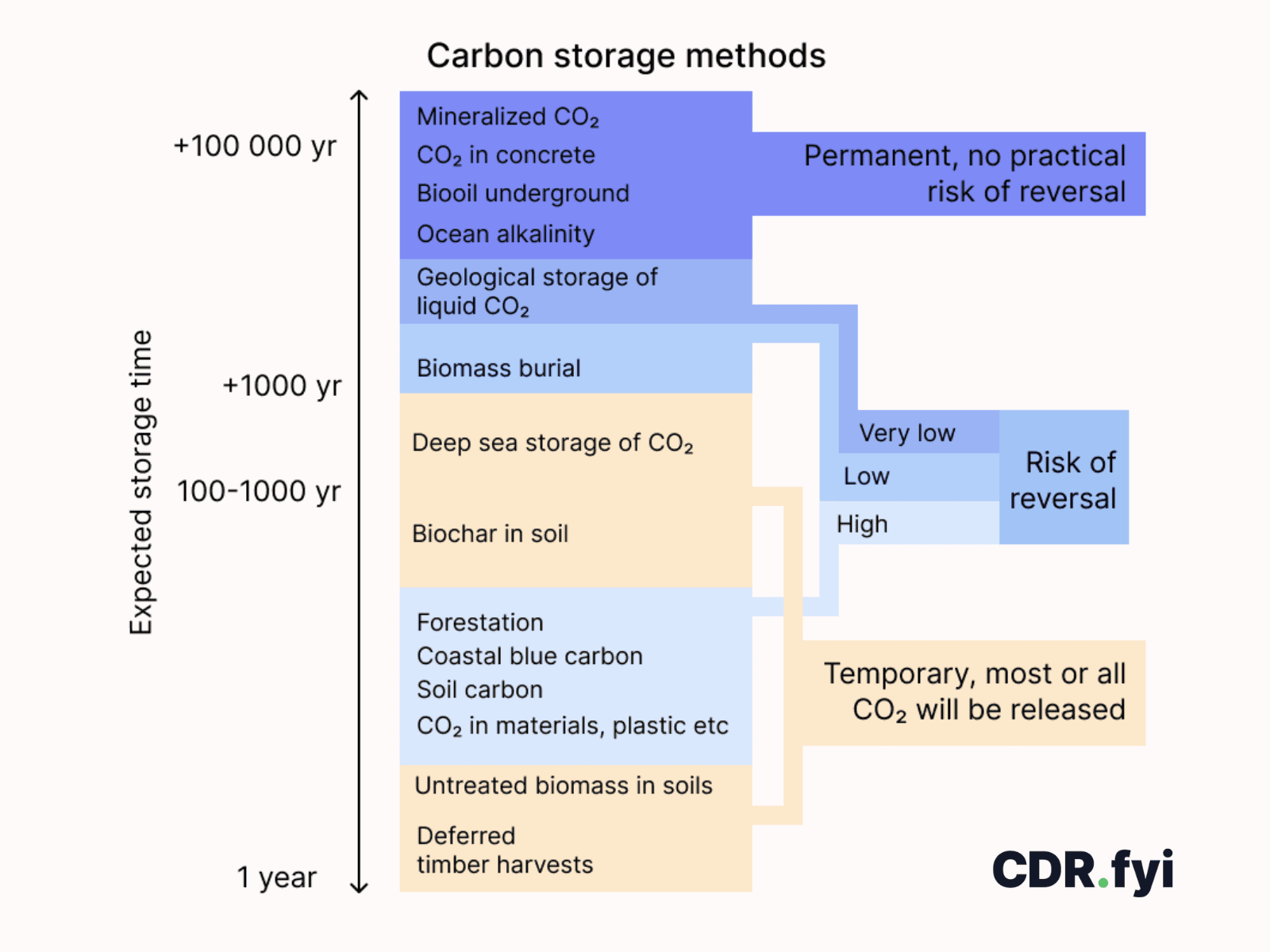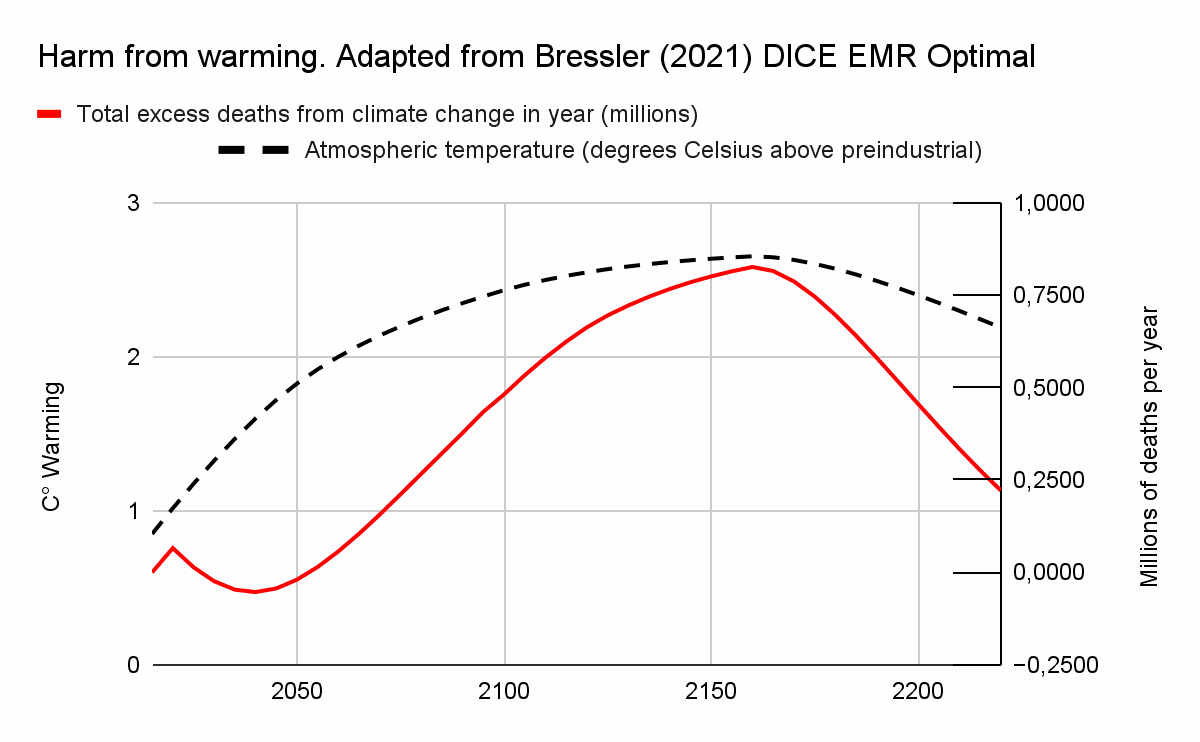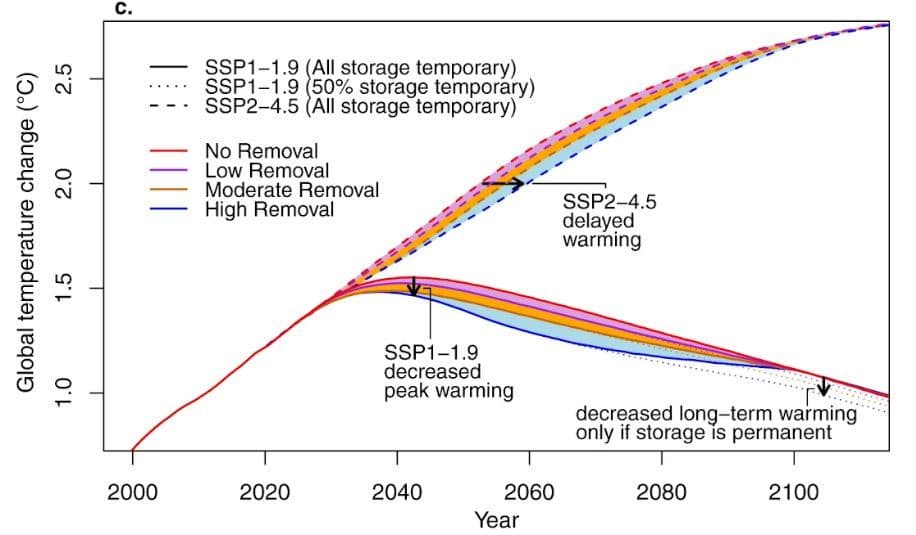June 19, 2024
Are Temporary and Permanent Carbon Stores Interchangeable?

Are three trees worth one rock? Permanent storage is always best, but given realistic assumptions on discounting of future damages, as well as long-term climate adaptation - carbon storage lasting centuries could be made comparable to permanent storage. However, carbon re-released before peak warming needs to be replaced and cannot be equalized to permanent CDR.
Does CO₂ always need to be removed permanently? Carbon insecurely or temporarily stored - such as in forests & soils - are cheaper and more scalable than permanent storage, such as direct air capture with storage. But since CO₂ lasts in the atmosphere for millennia, temporary CDR only postpones emissions - and very short-term storage does little or nothing to control peak warming.
Given this, how can temporary and permanent storage be accurately compared?
Although deploying temporary carbon storage instead of permanent leads to higher future temperatures, this could be acceptable if:
- Expired storage is replaced.
- The harm from warming decreases with time.
- Future harm is discounted.
If none of these applies, then harm from warming is enduring, and no amount of temporary sequestration could offset long-term damages.[i]
1) Expired storage is replaced
Reforestation carbon credits could be bought today, and replaced with permanent storage when the carbon is re-released (this practice is also described as horizontal stacking). Cost may favour temporary storage followed by future replacement if the sum of the cost of temporary storage and replacement is lower than the one-time cost of permanent storage today. Such scenarios can be explored using The Carbon Plan permanence calculator.
Choosing temporary storage might rely on the expectation that durable carbon removal prices will fall with time. However, if no one buys permanent CDR today, the absence of learning curve effects may mean costs do not fall.
Future costs of removal can also be discounted. Imagine you plan to replace temporary storage with permanent in 100 years. At $100/t with a nominal interest rate of 2%, $14 banked today pays the entire future replacement cost. This effect is unrelated to learning-curve cost reductions; it's purely based on the investment return made. However, if no one buys permanent storage today, it might not just fail to become cheaper but not be available at scale at all.
In either case, if used as an offsetting strategy, it could be difficult to ensure that temporary storage is actually replaced in the future - even if this strategy would be the most cost-effective. A company buying or deploying temporary removal today might not be around when it needs replacement. But there are theoretical solutions to this problem; trusts or foundations could be used, or responsibility could be shifted to governments.
2) The harm from warming decreases with time
In the short to medium-term, harm from warming will increase - as the negative effects of warming is nonlinear. Going from 2°C-3°C is much more disruptive than going from 1°C-2°C. When temperatures rise, the value of carbon storage increases with time. Very temporary storage is, therefore, almost useless if not replaced, since it avoids a smaller level of harm per tonne-year of storage than carbon stored when the temperatures are higher. If the storage you do is for only ten years, it actually makes sense to delay deployment until we're near peak temperatures.

The graph above shows how increased mortality from warming can follow an inverted U-shape. Here, harm becomes significant after 2°C warming and drops due to negative emissions after 2.65°C (2160). Data adapted from R. Daniel Bressler's paper The mortality cost of carbon
But what happens if temperatures plateau? A reasonable assumption is harm decreases due to adaptation. Rising incomes and learning curve effects spread adaptation technologies: storm-proof houses, air conditioning, drought-resistant seeds, early weather warning systems, etc. This effect is real: the number of weather-related disasters in the world has increased five times in 50 years, but fatalities fell by two-thirds. However, economic damages could increase even if fatalities fall; - fancy homes cost more to rebuild than tin shacks. This is not a law of nature, however; such adaptation progress may stop.
If temperatures start to go down, then harm from warming and the value of carbon storage decrease too. Temperatures could decrease for reasons unrelated to carbon removal, e.g. lower methane levels or increased albedo.
It should be kept in mind that estimates of future harm decreases have huge uncertainties. Current estimates likely underestimate future harm since there are more potential sources of harm than what we can put into models today. Climate sensitivity is also uncertain - i.e. how much warming a given amount of emissions leads to. The harms of any specific emission trajectory might be far worse than expected. Additional warming may come from unanticipated sensitivity, or from unexpected feedbacks (e.g. permafrost methane release).
3) Future harm is discounted
The harm future warming causes can also be discounted. This is standard economic practice. We most highly value immediate benefits and avoided harm. Partly, this reflects uncertainty. We understand near-time harm avoidance better than future effects. We might, for example, reach a technological breakthrough that addresses climate change, or an AI apocalypse wiping out humanity might make it irrelevant. Nevertheless, the opposite may apply - larger, poorer future populations could gravely suffer from climate change.
Even a low discount rate makes differences in avoided harm between long-term and permanent storage small. Using a discount rate of 1% equates carbon storage for around 500 years to permanent storage, and 2% would make 200-year storage almost as valuable as permanent. (A typical discount rate is 1-4%.) Another discounting approach uses an arbitrary time limit, like 1000 years. After this, you ignore all damages.
Discounting future harm at some rate seems reasonable. Without discounting, you spend as much to save a life in a million years as you are to save someone today. However, determining a rate is difficult, and involves balancing moral and practical considerations.
Equate short and long-term storage.
Economically discounting future harm, or anticipating adaption improvements makes it possible to equate permanent storage with a larger amount of temporary storage (also called vertical stacking).
Economists have proposed various approaches. Groom & Venman’s paper The social value of offsets, equates 2.5 tonnes stored for 50 years to 1 ton removed permanently using a 3,2% discount rate.
However, equating short-term and long-term carbon storage does not help reach the climate targets set in the Paris agreement or reduce peak temperatures. 50-year carbon storage would avoid short-term harm, but retain peak temperatures and associated tail risks including tipping points. These are thresholds of irreversible change such as Amazon dieback, gulf stream collapse, or glacier loss. Median estimates for the first two effects are that they happen at ~4°C, but they could occur at 2°C. Constraining temperature is crucial; harm is not fungible over time.
Longer storage suffers the same theoretical problem. Even millennial storage would not automatically reduce peak temperatures, but it would delay the peak. That would allow time for non-CDR mechanisms (e.g. reduction of other greenhouse gases) to lower temperatures, keeping the peak down. It could also shorten the peak, limiting harms such as glacier melt.

This graph from the paper Temporary nature-based carbon removal can lower peak warming in a well-below 2 °C scenario shows how peak warming can be delayed with temporary storage. The top (dotted lines) show the effect of short-term carbon storage in the SSP2-4.5 scenario where the world is headed today with peak warming after 2150. The bottom shows the SSP1-1.9 scenario, where the peak is reached in 2050. Decadal carbon storage would delay the peak in the latter, more optimistic, scenario but not in the former.
Conclusion
Given the above assumptions, time-limited carbon storage can be equated with long-term storage under some circumstances. Discounting future harm at some rate seems warranted, and harm from warming will likely decrease over time due to adaptation (after first increasing, due to temperature excesses). But it matters how time-limited storage is.
Using time-limited carbon storage to equate to permanent storage could be viable for deposits that last well beyond peak warming. Examples include biochar, biomass burial, and deep ocean storage. For example, if biochar retains 80% CO₂ stored after 100y, and 25% after 1000y, around 1.25 tonnes of biochar CO₂ storage equates to 1t permanent storage using a 1% discount rate [ii]. The practice would not be suitable for decadal storage - since that neither reduces nor delays peak temperatures [iii]. Discounting should be set conservatively (i.e. a low rate) - erring on the side of caution, considering future uncertainties.
Permanently replacing expiring short-term storage can be viable. If companies are temporarily offsetting, money for replacement should be set aside today. A conservative (low) discount rate should be used when budgeting for storage replacement, as well as using conservative (high) replacement costs. It should be kept in mind that early under-investment in permanent CDR will result in an immature market - causing high prices and constrained supply. Nature-based solutions such as forestation also have limited scaling potential and will not fill the needs of CDR, so new carbon removal solutions are needed in any case.
For offsetting, like-for-like removal is a good principle. Short carbon cycle emissions (e.g. land-use change) could be offset with biosphere carbon, whereas fossil fuel emissions from the long carbon cycle should be offset with long-lived removals.
Permanent storage is, however, always best since it removes future uncertainties and forever keeps peak temperatures down.
This article was first published by Robert Höglund in February, 2023 for Marginal Carbon.
Footnote
[i] One could also be wrong about the risk of reversal, and carbon storage that was expected to be short-lived turns out to last for thousands of years in practice, even without replacement. But that is a question about estimation, not about the value of truly short-lived carbon.
[ii] Based on this metastudy. New research points to biochar being more permanent than this, but it is yet to be peer-reviewed.
[iii] To touch on the point in footnote 1 again, what carbon storage will be re-released before peak temperatures is not an easy question to answer, and will be subject to further research. As noted in my storage classification article, forests are not inherently temporary, they just have a relatively high risk of reversal. It is entirely possible that a forestation project could have such a low risk of reversal that it is expected to last for many centuries.